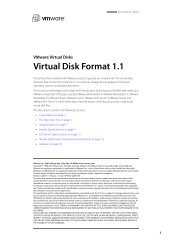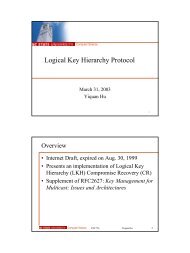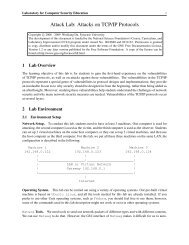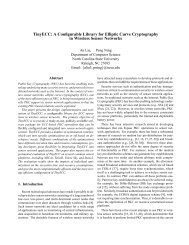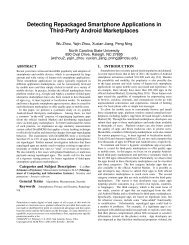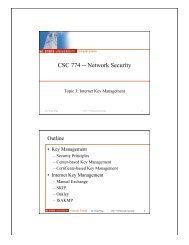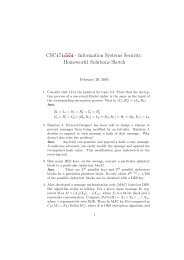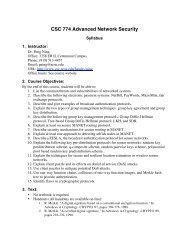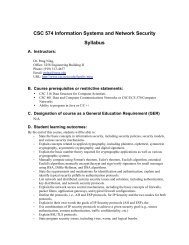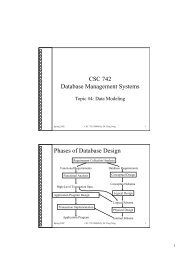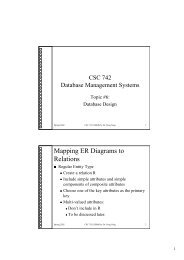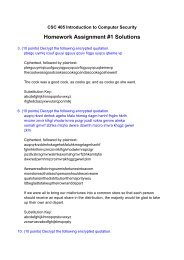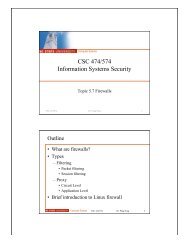Topic 5.2 - Dr. Peng Ning
Topic 5.2 - Dr. Peng Ning
Topic 5.2 - Dr. Peng Ning
Create successful ePaper yourself
Turn your PDF publications into a flip-book with our unique Google optimized e-Paper software.
Computer Science<br />
CSC 474 Network Security<br />
<strong>Topic</strong> <strong>5.2</strong> Public Key Cryptography<br />
CSC 474 <strong>Dr</strong>. <strong>Peng</strong> <strong>Ning</strong> 1<br />
Outline<br />
I. Introduction<br />
II. RSA<br />
III. Diffie-Hellman Key Exchange<br />
IV. Digital Signature Standard<br />
Computer Science CSC 474 <strong>Dr</strong>. <strong>Peng</strong> <strong>Ning</strong> 2<br />
Computer Science<br />
Introduction<br />
CSC 474 <strong>Dr</strong>. <strong>Peng</strong> <strong>Ning</strong> 3
Public Key Cryptography<br />
plaintext<br />
encryption<br />
ciphertext<br />
decryption<br />
plaintext<br />
Public key<br />
different!<br />
Private key<br />
• Invented and published in 1975<br />
• A public / private key pair is used<br />
– public key can be announced to everyone<br />
– private key is kept secret by the owner of the key<br />
• Also known as asymmetric cryptography<br />
• Much slower to compute than secret key cryptography<br />
Computer Science CSC 474 <strong>Dr</strong>. <strong>Peng</strong> <strong>Ning</strong> 4<br />
Applications of Public Key Crypto<br />
1. Message integrity with digital signatures<br />
Alice computes hash, signs with her private key (no one else<br />
can do this without her key)<br />
Bob verifies hash on receipt using Alice’s public key using the<br />
verification equation<br />
Plaintext<br />
Alice<br />
Signs<br />
Plaintext with<br />
digital signature<br />
Bob<br />
Verifies<br />
Signature<br />
Valid /<br />
Not Valid<br />
Alice’s Private Key<br />
Alice’s Public Key<br />
Computer Science CSC 474 <strong>Dr</strong>. <strong>Peng</strong> <strong>Ning</strong> 5<br />
Applications (Cont’d)<br />
• The digital signature is verifiable by anybody<br />
• Only one person can sign the message: nonrepudiation<br />
– Non-repudiation is only achievable with public<br />
key cryptography<br />
Computer Science CSC 474 <strong>Dr</strong>. <strong>Peng</strong> <strong>Ning</strong> 6
Applications (Cont’d)<br />
2. Communicating securely over an insecure channel<br />
– Alice encrypts plaintext using Bob’s public key, and Bob<br />
decrypts ciphertext using his private key<br />
– No one else can decrypt the message (because they don’t<br />
have Bob’s private key)<br />
Plaintext<br />
Alice<br />
Encrypts<br />
Ciphertext<br />
Bob<br />
Decrypts<br />
Plaintext<br />
Bob’s Public Key<br />
Bob’s Private Key<br />
Computer Science CSC 474 <strong>Dr</strong>. <strong>Peng</strong> <strong>Ning</strong> 7<br />
Applications (Cont’d)<br />
3. Secure storage on insecure medium<br />
– Alice encrypts data using her public key<br />
– Alice can decrypt later using her private key<br />
5. User Authentication<br />
– Bob proves his identity to Alice by using his<br />
private key to perform an operation (without<br />
divulging his private key)<br />
– Alice verifies result using Bob’s public key<br />
Computer Science CSC 474 <strong>Dr</strong>. <strong>Peng</strong> <strong>Ning</strong> 8<br />
Applications (Cont’d)<br />
5. Key exchange for secret key crypto<br />
– Alice and Bob use public key crypto to negotiate<br />
a shared secret key between them<br />
Computer Science CSC 474 <strong>Dr</strong>. <strong>Peng</strong> <strong>Ning</strong> 9
Public Key Algorithms<br />
• Public key algorithms covered in this class, and their<br />
applications<br />
System Encryption /<br />
Decryption?<br />
Digital<br />
Signatures?<br />
Key<br />
Exchange?<br />
RSA Yes Yes Yes<br />
Diffie-<br />
Hellman<br />
DSA<br />
Yes<br />
Yes<br />
Computer Science CSC 474 <strong>Dr</strong>. <strong>Peng</strong> <strong>Ning</strong> 10<br />
Public-Key Requirements<br />
• It must be computationally<br />
– easy to generate a public / private key pair<br />
– hard to determine the private key, given the public<br />
key<br />
• It must be computationally<br />
– easy to encrypt using the public key<br />
– easy to decrypt using the private key<br />
– hard to recover the plaintext message from just the<br />
ciphertext and the public key<br />
Computer Science CSC 474 <strong>Dr</strong>. <strong>Peng</strong> <strong>Ning</strong> 11<br />
Trapdoor One-Way Functions<br />
• Trapdoor one-way function<br />
– Y=f k (X): easy to compute if k and X are known<br />
– X=f -1 k(Y): easy to compute if k and Y are known<br />
– X=f -1 k(Y): hard if Y is known but k is unknown<br />
• Goal of designing public-key algorithm is to<br />
find appropriate trapdoor one-way function<br />
Computer Science CSC 474 <strong>Dr</strong>. <strong>Peng</strong> <strong>Ning</strong> 12
Computer Science<br />
The RSA Algorithm<br />
CSC 474 <strong>Dr</strong>. <strong>Peng</strong> <strong>Ning</strong> 13<br />
RSA (Rivest, Shamir, Adleman)<br />
• The most popular public key method<br />
– provides both public key encryption and digital<br />
signatures<br />
• Basis: factorization of large numbers is hard<br />
• Variable key length (1024 bits or greater)<br />
• Variable plaintext block size<br />
– plaintext block size must be smaller than key size<br />
– ciphertext block size is same as key size<br />
Computer Science CSC 474 <strong>Dr</strong>. <strong>Peng</strong> <strong>Ning</strong> 14<br />
Generating a Public/Private Key Pair<br />
• Find (using Miller-Rabin) large primes p and q<br />
• Let n = p*q<br />
• do not disclose p and q!<br />
• φ(n) = ???<br />
• Choose an e that is relatively prime to φ(n)<br />
• public key = <br />
• Find d = multiplicative inverse of e mod φ(n) (i.e.,<br />
e*d = 1 mod φ(n))<br />
• private key = <br />
Computer Science CSC 474 <strong>Dr</strong>. <strong>Peng</strong> <strong>Ning</strong> 15
RSA Operations<br />
• For plaintext message m and ciphertext c<br />
Encryption: c = m e mod n, m < n<br />
Decryption: m = c d mod n<br />
Signing: s = m d mod n, m < n<br />
Verification: m = s e mod n<br />
Computer Science CSC 474 <strong>Dr</strong>. <strong>Peng</strong> <strong>Ning</strong> 16<br />
RSA Example: Encryption and Signing<br />
• Choose p = 23, q = 11 (both primes)<br />
– n = p*q = 253<br />
– φ(n) = (p-1)(q-1) = 220<br />
• Choose e = 39 (relatively prime to 220)<br />
– public key = <br />
• Find e -1 mod 220 = d = 79<br />
(note: 39*79 ≡ 1 mod 220)<br />
– private key = <br />
Computer Science CSC 474 <strong>Dr</strong>. <strong>Peng</strong> <strong>Ning</strong> 17<br />
Example (Cont’d)<br />
• Suppose plaintext m = 80<br />
Encryption<br />
c = 80 39 mod 253 = ____ (c = m e mod n)<br />
Decryption<br />
m = ____ 79 mod 253 = 80 (c d mod n)<br />
Signing (in this case, for entire message m)<br />
s = 80 79 mod 253 = ____ (s = m d mod n)<br />
Verification<br />
m = ____ 39 mod 253 = 80 (s e mod n)<br />
Computer Science CSC 474 <strong>Dr</strong>. <strong>Peng</strong> <strong>Ning</strong> 18
Example (Cont’d)<br />
• Suppose plaintext m = 80<br />
Encryption<br />
c = 80 39 mod 253 = 37 (c = m e mod n)<br />
Decryption<br />
m = 37 79 mod 253 = 80 (c d mod n)<br />
Signing (in this case, for entire message m)<br />
s = 80 79 mod 253 = 224 (s = m d mod n)<br />
Verification<br />
m = 224 39 mod 253 = 80 (s e mod n)<br />
Computer Science CSC 474 <strong>Dr</strong>. <strong>Peng</strong> <strong>Ning</strong> 19<br />
Another Example<br />
• Choose p = 17, q = 11 (both primes)<br />
– n = p*q = 187<br />
– φ(n) = (p-1)(q-1) = 160<br />
• Choose e = 7 (relatively prime to 160)<br />
– public key = <br />
• Find e -1 mod 160 = d = 23<br />
i.e., 7*23 = 1 mod 160<br />
– private key = <br />
Computer Science CSC 474 <strong>Dr</strong>. <strong>Peng</strong> <strong>Ning</strong> 20<br />
Example (Cont’d)<br />
• Suppose plaintext m = 88<br />
• Encryption<br />
– c = 11 = 88 7 mod 187 (c = m e mod n)<br />
• Decryption<br />
– m = 88 = 11 23 mod 187 (c d mod n)<br />
• Signing (entire message, not just hash)<br />
– s = 11 = 88 23 mod 187 (s = m d mod n)<br />
• Verification<br />
– m = 88 = 11 7 mod 187 (s e mod n)<br />
why the same???!<br />
Computer Science CSC 474 <strong>Dr</strong>. <strong>Peng</strong> <strong>Ning</strong> 21
Using RSA for Key Negotiation<br />
• Procedure<br />
1. A sends random number R1 to B, encrypted with<br />
B’s public key<br />
2. B sends random number R2 to A, encrypted with<br />
A’s public key<br />
3. A and B both decrypt received messages using<br />
their respective private keys<br />
4. A and B both compute K = H(R1⊕R2), and use<br />
that as the shared key<br />
Computer Science CSC 474 <strong>Dr</strong>. <strong>Peng</strong> <strong>Ning</strong> 22<br />
Key Negotiation Example<br />
• For Alice, e = 39, d = 79, n = 253<br />
• For Bob, e = 23, d = 47, n = 589 (=19*31)<br />
• Let R1 = 15, R2 = 55<br />
1. Alice sends 306 = 15 23 mod 589 to Bob<br />
2. Bob sends 187 = 55 39 mod 253 to Alice<br />
3. Alice computes R2 = 55 = 187 79 mod 253<br />
4. Bob computes R1 = 15 = 306 47 mod 589<br />
5. A and B both compute K = H(R1⊕R2), and use<br />
that as the shared key<br />
Computer Science CSC 474 <strong>Dr</strong>. <strong>Peng</strong> <strong>Ning</strong> 23<br />
Proof of Correctness (D(E(m)) = m)<br />
• Given<br />
– public key = and private key = <br />
– n =p*q, φ(n) =(p-1)(q-1)<br />
– e*d ≡ 1 mod φ(n)<br />
• If encryption is c = m e mod n, decryption…<br />
= c d mod n<br />
= (m e ) d mod n = m ed mod n<br />
= m mod n (why?)<br />
= m (since m < n)<br />
• (digital signature proof is similar)<br />
Computer Science CSC 474 <strong>Dr</strong>. <strong>Peng</strong> <strong>Ning</strong> 24
Is RSA Secure?<br />
• is public information<br />
• If you could factor n into p*q, then<br />
– could compute φ(n) =(p-1)(q-1)<br />
– could compute d = e -1 mod φ(n)<br />
– would know the private key !<br />
• But: factoring large integers is hard!<br />
– classical problem worked on for centuries; no<br />
known reliable, fast method<br />
Computer Science CSC 474 <strong>Dr</strong>. <strong>Peng</strong> <strong>Ning</strong> 25<br />
Security (Cont’d)<br />
• At present, key sizes of 1024 bits are<br />
considered to be secure, but 2048 bits is<br />
better<br />
• Tips for making n difficult to factor<br />
1. p and q lengths should be similar (ex.: ~500 bits<br />
each if key is 1024 bits)<br />
2. both (p-1) and (q-1) should contain a “large”<br />
prime factor<br />
3. gcd(p-1, q-1) should be “small”<br />
4. d should be larger than n 1/4<br />
Computer Science CSC 474 <strong>Dr</strong>. <strong>Peng</strong> <strong>Ning</strong> 26<br />
Attacks Against RSA<br />
• Brute force: try all possible private keys<br />
– can be defeated by using a large enough key<br />
space (e.g., 1024 bit keys or larger)<br />
• Mathematical attacks<br />
1. factor n (possible for special cases of n)<br />
2. determine d directly from e, without computing<br />
φ(n)<br />
– at least as difficult as factoring n<br />
Computer Science CSC 474 <strong>Dr</strong>. <strong>Peng</strong> <strong>Ning</strong> 27
Attacks (Cont’d)<br />
• Probable-message attack (using )<br />
– encrypt all possible plaintext messages<br />
– try to find a match between the ciphertext and one of the<br />
encrypted messages<br />
– only works for small plaintext message sizes<br />
• Solution: pad plaintext message with random text<br />
before encryption<br />
• PKCS #1 v1 specifies this padding format:<br />
00<br />
02 R1 R2 R3 R4 R5 R6 R7 R8 00 data…<br />
each 8 bits long<br />
Computer Science CSC 474 <strong>Dr</strong>. <strong>Peng</strong> <strong>Ning</strong> 28<br />
Timing Attacks Against RSA<br />
• Recovers the private key from the running time of the<br />
decryption algorithm<br />
• Computing m = c d mod n using repeated<br />
squaring algorithm:<br />
• m = 1;<br />
• for i = k-1 downto 1<br />
m = m*m mod n;<br />
if d i == 1<br />
then m = m*c mod n;<br />
• return m;<br />
Computer Science CSC 474 <strong>Dr</strong>. <strong>Peng</strong> <strong>Ning</strong> 29<br />
Timing Attacks (Cont’d)<br />
The attack proceeds bit by bit<br />
Attacker assumed to know c, m<br />
Attacker is able to determine bit i of d because for<br />
some c and m, the highlighted step is extremely slow<br />
if d i = 1<br />
Computer Science CSC 474 <strong>Dr</strong>. <strong>Peng</strong> <strong>Ning</strong> 30
Countermeasures to Timing Attacks<br />
1. Delay the result if the computation is too fast<br />
– disadvantage: ?<br />
2. Add a random delay<br />
– disadvantage?<br />
3. Blinding: multiply the ciphertext by a random<br />
number before performing decryption<br />
Computer Science CSC 474 <strong>Dr</strong>. <strong>Peng</strong> <strong>Ning</strong> 31<br />
RSA’s Blinding Algorithm<br />
• To confound timing attacks during decryption<br />
1. generate a random number r between 0 and n–1 such that<br />
gcd(r, n) = 1<br />
2. compute c’ = c * r e mod n<br />
this is where<br />
3. compute m’ = (c’) d mod n<br />
timing attack<br />
4. compute m = m’ * r –1 mod n<br />
would occur<br />
• Attacker will not know what the bits of c’ are<br />
• Performance penalty: < 10% slowdown in<br />
decryption speed<br />
Computer Science CSC 474 <strong>Dr</strong>. <strong>Peng</strong> <strong>Ning</strong> 32<br />
Computer Science<br />
Diffie-Hellman Key Exchange<br />
CSC 474 <strong>Dr</strong>. <strong>Peng</strong> <strong>Ning</strong> 33
Diffie-Hellman Protocol<br />
• For negotiating a shared secret key using only<br />
public communication<br />
• Does not provide authentication of<br />
communicating parties<br />
• What’s involved?<br />
– p is a large prime number (about 512 bits)<br />
– g is a primitive root of p, and g < p<br />
– p and g are publicly known<br />
Computer Science CSC 474 <strong>Dr</strong>. <strong>Peng</strong> <strong>Ning</strong> 34<br />
D-H Key Exchange Protocol<br />
Alice<br />
Publishes or sends g and p<br />
Bob<br />
Reads g and p<br />
Picks random number S A<br />
(and keeps private)<br />
Computes public key<br />
T A = g S A mod p<br />
Picks random number S B<br />
(and keeps private)<br />
Computes public key<br />
T B = g S B mod p<br />
Sends T A to Bob,<br />
reads T B from Bob<br />
Computes T B<br />
S A mod p<br />
=<br />
Sends T B to Alice,<br />
reads T A from Alice<br />
Computes T A<br />
S B mod p<br />
Computer Science CSC 474 <strong>Dr</strong>. <strong>Peng</strong> <strong>Ning</strong> 35<br />
Key Exchange (Cont’d)<br />
Alice and Bob have now both computed the same secret g S A S B<br />
mod p, which can then be used as the shared secret key K<br />
S A is the discrete logarithm of g S A mod p and<br />
S B is the discrete logarithm of g S B mod p<br />
=<br />
Computer Science CSC 474 <strong>Dr</strong>. <strong>Peng</strong> <strong>Ning</strong> 36
D-H Example<br />
• Let p = 353, g = 3<br />
• Let random numbers be S A = 97, S B = 233<br />
• Alice computes T A = ___ mod __ = 40 = g S A mod p<br />
• Bob computes T B = ___ mod ___ = 248 = g S B mod p<br />
• They exchange T A and T B<br />
• Alice computes K = __ mod __ = 160 = T B<br />
S A mod p<br />
• Bob computes K = __ mod ___ = 160 = T A<br />
S B mod p<br />
Computer Science CSC 474 <strong>Dr</strong>. <strong>Peng</strong> <strong>Ning</strong> 37<br />
D-H Example<br />
• Let p = 353, g = 3<br />
• Let random numbers be S A = 97, S B = 233<br />
• Alice computes T A = 3 97 mod 353 = 40 = g S A mod p<br />
• Bob computes T B = 3 233 mod 353 = 248 = g S B mod p<br />
• They exchange T A and T B<br />
• Alice computes K = 248 97 mod 353 = 160 =T B<br />
S A mod p<br />
• Bob computes K = 40 233 mod 353 = 160 =T A<br />
S B mod p<br />
Computer Science CSC 474 <strong>Dr</strong>. <strong>Peng</strong> <strong>Ning</strong> 38<br />
Why is This Secure?<br />
• Discrete log problem:<br />
– given T A (= g S A mod p), g, and p, it is<br />
computationally infeasible to compute S A<br />
– (note: as always, to the best of our knowledge;<br />
doesn’t mean there isn’t a method out there<br />
waiting to be found)<br />
– same statement can be made for T B , g, p, and S B<br />
Computer Science CSC 474 <strong>Dr</strong>. <strong>Peng</strong> <strong>Ning</strong> 39
D-H Limitations<br />
• Expensive exponential operation is required<br />
– possible timing attacks??<br />
• Algorithm is useful for key negotiation only<br />
– i.e., not for public key encryption<br />
• Not for user authentication<br />
– In fact, you can negotiate a key with a complete<br />
stranger!<br />
Computer Science CSC 474 <strong>Dr</strong>. <strong>Peng</strong> <strong>Ning</strong> 40<br />
Man-In-The-Middle Attack<br />
• Trudy impersonates as Alice to Bob, and<br />
also impersonates as Bob to Alice<br />
Alice<br />
g S A = 3 97 mod 353<br />
Trudy<br />
Bob<br />
g S ”A”<br />
g S ”B” = 3 233 mod 353<br />
g S B<br />
K1 = 248 97 mod 353 =<br />
40 233 mod 353 = 160<br />
K2 = (g S B) S ”A”<br />
Computer Science CSC 474 <strong>Dr</strong>. <strong>Peng</strong> <strong>Ning</strong> 41<br />
Man-In-The-Middle Attack (Cont’d)<br />
• Now, Alice thinks K1 is the shared key, and<br />
Bob thinks K2 is the shared key<br />
• Trudy intercepts messages from Alice to Bob,<br />
and<br />
– decrypts (using K1), substitutes her own message,<br />
and encrypts for Bob (using K2)<br />
– likewise, intercepts and substitutes messages from<br />
Bob to Alice<br />
• Solution???<br />
Computer Science CSC 474 <strong>Dr</strong>. <strong>Peng</strong> <strong>Ning</strong> 42
Authenticating D-H Messages<br />
• That is, you know who you’re negotiating<br />
with, and that the messages haven’t been<br />
modified<br />
• Requires that communicating parties already<br />
share some kind of a secret<br />
• Then use encryption, or a MAC (based on<br />
this previously-shared secret), of the D-H<br />
messages<br />
Computer Science CSC 474 <strong>Dr</strong>. <strong>Peng</strong> <strong>Ning</strong> 43<br />
Using D-H in “Phone Book” Mode<br />
1. Alice and Bob each choose a semi-permanent secret<br />
number, generate T A and T B<br />
2. Alice and Bob publish T A , T B, i.e., Alice can get<br />
Bob’s T B at any time, Bob can get Alice’s T A at any<br />
time<br />
3. Alice and Bob can then generate a semi-permanent<br />
shared key without communicating<br />
– but, they must be using the same p and g<br />
• Essential requirement: reliability of the published<br />
values (no one can substitute false values)<br />
– how accomplished???<br />
Computer Science CSC 474 <strong>Dr</strong>. <strong>Peng</strong> <strong>Ning</strong> 44<br />
Encryption Using D-H?<br />
• How to do key distribution + message encryption<br />
in one step<br />
• Everyone computes and publishes their own<br />
individual , where T i =g i<br />
Si mod p i<br />
• For Alice to communicate with Bob…<br />
1. Alice picks a random secret S A<br />
2. Alice computes g B<br />
S A mod pB<br />
3. Alice uses K AB = T B<br />
S A mod pB to encrypt the message<br />
4. Alice sends encrypted message along with<br />
(unencrypted) g B<br />
S A mod pB<br />
Computer Science CSC 474 <strong>Dr</strong>. <strong>Peng</strong> <strong>Ning</strong> 45
Encryption (Cont’d)<br />
• For Bob to decipher the encrypted message<br />
from Alice<br />
1. Bob computes K AB = (g B<br />
S A) S B mod pB<br />
2. Bob decrypts message using K AB<br />
Computer Science CSC 474 <strong>Dr</strong>. <strong>Peng</strong> <strong>Ning</strong> 46<br />
Example<br />
• Bob publishes = and<br />
keeps secret S B = 58<br />
• Steps<br />
1. Alice picks a random secret S A = 17<br />
2. Alice computes g B<br />
S A mod pB = ___ mod ___ = 173<br />
3. Alice uses K AB = T B<br />
S A mod pB =<br />
___ mod ___ = 360 to encrypt message M<br />
4. Alice sends encrypted message along with<br />
(unencrypted) g B<br />
S A mod pB = 173<br />
5. Bob computes K AB = (g B<br />
S A) S B mod pB =<br />
___ mod ___ = 360<br />
6. Bob decrypts message M using K AB<br />
Computer Science CSC 474 <strong>Dr</strong>. <strong>Peng</strong> <strong>Ning</strong> 47<br />
Example<br />
• Bob publishes = and<br />
keeps secret S B = 58<br />
• Steps<br />
1. Alice picks a random secret S A = 17<br />
2. Alice computes g B<br />
S A mod pB = 5 17 mod 401 = 173<br />
3. Alice uses K AB = T B<br />
S A mod pB =<br />
51 17 mod 401 = 360 to encrypt message M<br />
4. Alice sends encrypted message along with<br />
(unencrypted) g B<br />
S A mod pB = 173<br />
5. Bob computes K AB = (g B<br />
S A) S B mod pB =<br />
173 58 mod 401 = 360<br />
6. Bob decrypts message M using K AB<br />
Computer Science CSC 474 <strong>Dr</strong>. <strong>Peng</strong> <strong>Ning</strong> 48
Picking g and p<br />
• Advisable to change g and p periodically<br />
– the longer they are used, the more info available to<br />
an attacker<br />
• Advisable not to use same g and p for<br />
everybody<br />
• For “obscure mathematical reasons”…<br />
– (p-1)/2 should be prime<br />
– g (p-1)/2 should be ≡ -1 mod p<br />
Computer Science CSC 474 <strong>Dr</strong>. <strong>Peng</strong> <strong>Ning</strong> 49<br />
Computer Science<br />
Digital Signature Standard (DSS)<br />
CSC 474 <strong>Dr</strong>. <strong>Peng</strong> <strong>Ning</strong> 50<br />
Digital Signature Standard (DSS)<br />
• Useful only for digital signing (no encryption<br />
or key exchange)<br />
• Components<br />
– SHA-1 to generate a hash value (some other hash<br />
functions also allowed now)<br />
– Digital Signature Algorithm (DSA) to generate the<br />
digital signature from this hash value<br />
• Designed to be fast for the signer rather than<br />
verifier<br />
– e.g., for use in smart cards<br />
Computer Science CSC 474 <strong>Dr</strong>. <strong>Peng</strong> <strong>Ning</strong> 51
Digital Signature Algorithm (DSA)<br />
1. Announce public parameters used for signing<br />
– pick p (a prime with >= 1024 bits) ex.: p = 103<br />
– pick q (a 160 bit prime) such that q|(p-1)<br />
– choose g ≡ h (p-1)/q mod p, where 1 < h < (p – 1),<br />
such that g > 1 ex.: if h = 2, g = 2 6 mod 103 = 64<br />
– note: g is of order q mod p<br />
ex.: q = 17 (divides 102)<br />
ex.: powers of 64 mod 103 =<br />
64 79 9 61 93 81 34 13 8 100 14 72 76 23 30 66 1<br />
17 values<br />
Computer Science CSC 474 <strong>Dr</strong>. <strong>Peng</strong> <strong>Ning</strong> 52<br />
DSA (Cont’d)<br />
2. User Alice generates a long-term private key x M<br />
– random integer with 0 < x M < q<br />
ex.: x M = 13<br />
4. Alice generates a long-term public key y M<br />
– y M = g x M mod p<br />
ex.: y M = 64 13 mod 103 = 76<br />
Computer Science CSC 474 <strong>Dr</strong>. <strong>Peng</strong> <strong>Ning</strong> 53<br />
DSA (Cont’d)<br />
ex.: p = 103, q = 17, g = 64, x M = 13, y M = 76<br />
4. Alice randomly picks a private key k such that<br />
0 < k < q, and generates k -1 mod q<br />
5. Signing message M<br />
– public key r = (g k mod p) mod q<br />
– signature s = [k -1 (H(M)+x M r)] mod q<br />
– transmitted info = M, r, s<br />
ex.: k = 12, 12 -1 mod 17 = 10<br />
ex.: r = (64 12 mod 103) mod 17 = 4<br />
ex.: s = [10 * (75 + 13*4)] mod 17 = 12<br />
ex.: H(M) = 75<br />
ex.: M, 4, 12<br />
Computer Science CSC 474 <strong>Dr</strong>. <strong>Peng</strong> <strong>Ning</strong> 54
Verifying a DSA Signature<br />
• Known : g, p, q, y M<br />
• Received from signer: M, r, s<br />
1. w = (s) -1 mod q<br />
2. u 1 = [H(M)w] mod q<br />
3. u 2 = (r*w) mod q<br />
4. v = [(g u1 *y M<br />
u2<br />
) mod p] mod q<br />
ex.: p = 103, q = 17, g = 64, y M = 76, H(M) = 75<br />
5. If v = r, then the signature is verified<br />
ex.: M, 4, 12<br />
ex.: w = 12 -1 mod 17 = 10<br />
ex.: u 1 = 75*10 mod 17 = 2<br />
ex.: u 2 = 4*10 mod 17 = 6<br />
ex.: v = [(64 2 * 76 6 ) mod 103] mod 17 = 4<br />
Computer Science CSC 474 <strong>Dr</strong>. <strong>Peng</strong> <strong>Ning</strong> 55<br />
Verifying DSA Signature<br />
• Received: M, r=13, s=24<br />
1. w = (s) -1 mod q = 24<br />
2. u 1 = [H(M)w] mod q = 22*24 mod 25 = 3<br />
3. u 2 = (r)w mod q = 13 * 24 mod 25 = 12<br />
4. v = [(g u1 y A<br />
u2<br />
) mod p] mod q =<br />
[5 3 * 56 12 mod 101] mod 25 = 13<br />
5. If v = r, then the signature is verified<br />
Computer Science CSC 474 <strong>Dr</strong>. <strong>Peng</strong> <strong>Ning</strong> 56<br />
Why Does it Work?<br />
• Correct? The signer computes<br />
• s = k -1 * (H(m) + x*r) mod q<br />
• so k ≡ H(m)*s -1 + x*r*s -1<br />
• ≡ H(m)*w + x*r*w mod q<br />
• Since g has order q:<br />
• g k ≡ g H(m)w * g xrw<br />
• ≡ g H(m)w * y rw<br />
• ≡ g u1 * y u2 mod p, and<br />
• r = (g k mod p) mod q = (g u1 *y u2 mod p) mod q = v<br />
Computer Science CSC 474 <strong>Dr</strong>. <strong>Peng</strong> <strong>Ning</strong> 57
Is it Secure?<br />
• Given y M , it is difficult to compute x M<br />
— x M is the discrete log of y M to the base g,<br />
mod p<br />
• Likewise, given r, it is difficult to compute k<br />
• Cannot forge a signature without x M<br />
• Signatures are not repeated (only used once<br />
per message) and cannot be replayed<br />
Computer Science CSC 474 <strong>Dr</strong>. <strong>Peng</strong> <strong>Ning</strong> 58<br />
Assessment of DSA<br />
• Slower to verify than RSA, but faster signing<br />
than RSA<br />
• Key lengths of 2048 bits and greater are also<br />
allowed<br />
Computer Science CSC 474 <strong>Dr</strong>. <strong>Peng</strong> <strong>Ning</strong> 59



